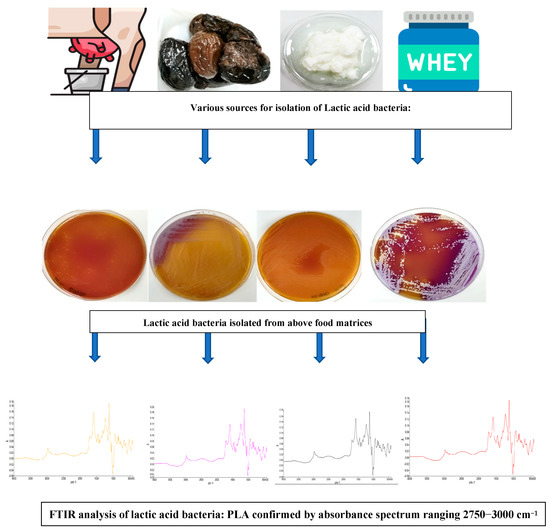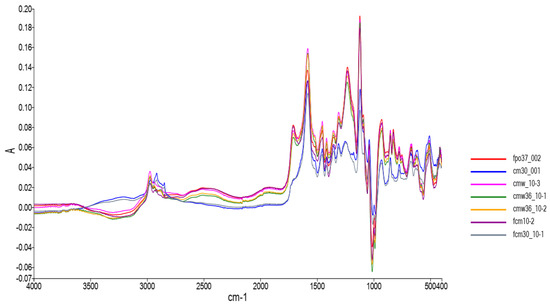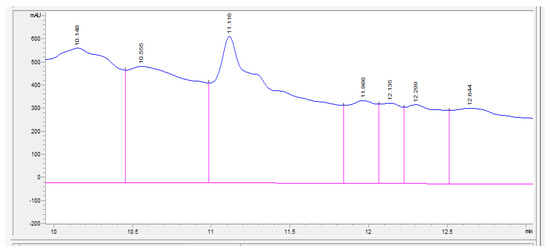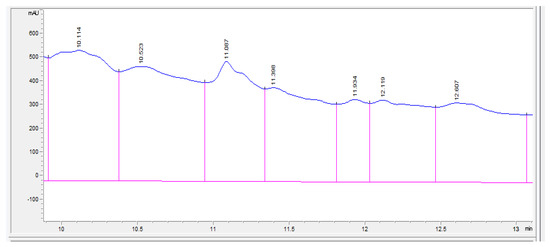Abstract
Cheese whey (CW) is the residual liquid waste from cheese manufacturing industries, and it is rich in diverse nutrients with the potential for usage as a growth matrix for sustaining lactic acid bacteria (LAB) fermentation. Lactic acid (LA), phenyllactic acid (PLA), and their derivatives are green chemicals that can be produced by LAB metabolism with the revalorization of CW. LA and PLA are known for their antimicrobial properties, immunoregulatory functions, and production of biobased polymers (biodegradable plastics) like poly lactic acid and poly-phenyl lactic acid; hence, they find numerous applications in agricultural/food-based, pharmaceutical, biochemistry, or medical fields, as well as in antibiotic supplements in livestock feeds for animal husbandry. Herewith, we discuss our experimental strategy/concept (that can be implemented) for the microbial fermentation of cheese whey streams using robust LAB co-cultures to produce 3-PLA through sequential steps, adding a note upon their possible applications hereof. It is proposed that various food matrices, like raw cow milk, fermented cow milk, and fermented table olives, will be screened for the isolation of robust lactic acid bacteria that can be used as starter cultures for the fermentation of cheese whey liquids for producing augmented levels of LA and/or PLA. Moreover, we discuss the feasibility of practically producing PLA using an orchestrated assemblage of simple procedures, viz., isolating robust LAB strains from natural food matrices, tailoring LAB growth using a selective medium sustenance, adopting adaptive evolution procedures for improving resistance to higher temperatures and tolerance to lactic acid and/or cheese whey (low-cost substrate), and using FTIR and HPLC tools for analyzing the PLA content produced. Two Lactobacillus isolates (CM30_001 and CMW_10−3), sourced from raw cow milk and fermented cow milk whey, were found to produce 3-PLA contents of 39 mg/L and 32 mg/L in batch fermentation, using this proposed strategy.
1. Introduction
Cheese whey (CW) is the residual liquid waste from cheese manufacturing industries, and it is rich in diverse nutrients with the potential for usage as a growth matrix for sustaining lactic acid bacteria (LAB) fermentation [1,2]. Lactic acid (LA), phenyllactic acid (PLA), and their derivatives are green chemicals that can be produced by LAB metabolism with the revalorization of CW [3,4]. LAB serve as the fermentation agents of the food industry as they can produce myriad food products. CW and second CW are the major side-products during the cheese-manufacturing process, and they can be valorized into various biotechnological products [5]. As various industrial sectors are keenly in search of novel–green techniques to mitigate the usage of chemical preservatives in foods, it is imperative to recognize the whey waste of the cheese industry as a potential low-cost but nutrient-rich substrate that can be valorized into useful products [2]. CW hydrolysates augmented with phenyl pyruvic acid and other nutrients when fermented with Lactobacillus plantarum CECT221 could yield LA and PLA of antimicrobial grade [4,6]. The LAB fermentation of yellow mustard and milk whey (as substrates) resulted in the production of DL-3-PLA and LA with considerable antioxidant activity [7]. It was recently reported that LAB-fermented whey could effectively be used as a bio-preservative that could extend the shelf life of bread [8]. Considering the state of the art in numerous research works using cheese whey and the production of marketable organic compounds like LA and PLA, our current study aims to isolate robust LAB from diverse food matrices, like raw cow milk, fermented cow milk, and fermented table olives, and use these LAB isolates as starter cultures for the fermentation of cheese whey liquids for producing organic compounds like LA and PLA. Within the context of this article, the analysis of 3-PLA production using LAB isolates from four sources was investigated.
2. Materials and Methods
A group of LAB strains were isolated from freshly milked raw cow milk, naturally fermented cow milk, and fermented table olives, that were procured from the local vendor, using regular procedures [9]. Four kinds of samples were prepared: CM (raw cow milk), FCM (48 h naturally fermented cow milk curd, 30 °C), fermented cow milk whey (CMW), FPO (fermented pickled olives). These four samples were inoculated into MRS agar medium supplemented with cheese whey (30% v/v), CaCO3 (5 g/L), and Bromocresol purple (0.12 g/L)—with quadrant streaking to identify LA/PLA-producing lactic acid bacteria—and were fermented at 37 °C for 48 h [10]. The strains which showed PLA production positively using FTIR analysis were subjected to HPLC studies to analyze contents of PLA production. Elution was performed with methanol/0.05% TFA (solvent A) and water/0.05% TFA (solvent B) at 1 mL/min and A/B ratios of 10:90, 100:0, 100:0, and 10:90, with run times of 0, 20, 23, and 25 min, respectively; PLA was also eluted at the 11th minute by other researchers using similar protocol [11].
3. Results and Discussion
LAB strains sourced from four types of samples were analyzed for their ability to produce PLA. The LAB grown on MRS agar containing plates supplemented with cheese whey (30% v/v) for 24 h at 37 °C showed yellowish–orange-colored zones around them due to the hydrolysis by lactate dehydrogenase (LDH) enzyme, while non-LAB bacteria showed less/no discoloration around them, making the agar remain violet/purple as per regular protocol studies [10] (Figure 1). LAB strains (one each) from each food matrix source, which showed comparatively brighter yellow–orange zones (which symbolizes better production of LA and PLA) are shown in the schematic representation (Figure 1). The LAB isolate sourced from CMW was shown to produce the comparatively better hydrolysis zone; moreover, the absorbance reading in the FTIR spectrum was also the highest (Figure 2). This can be interpreted as the following: the higher the absorbance reading, the higher the concentration of the molecules in study (directly proportional to the PLA yield) [12]. A total of seven strains/isolates that were found to have positive PLA activity, as confirmed with the FTIR absorbance spectrum occurrence in the range of 2750–3000 cm−1, were chosen (Figure 2) to be used for adaptive evolution studies for improving the metabolic tolerance to LA (lactic acid) and higher temperature; resultantly, the seven strains were cultivated for tolerating temperatures of up to 37 °C and LA (lactic acid) content of up to 30 g/L. These adaptively evolved tolerant strains were checked again for PLA production using HPLC experimentation and two strains, viz., Sample 2: Isolate CM30_001 and Sample 6: Isolate CMW_10−3 showed PLA peaks eluted at the 11.116th min and 11.087th min of time intervals (Figure 3 and Figure 4). Elution was performed with methanol/0.05% TFA (solvent A) and water/0.05% TFA (solvent B) at 1 mL/min and A/B ratios of 10:90, 100:0, 100:0, and 10:90, with run times of 0, 20, 23, and 25 min, respectively; PLA was also eluted at the 11th minute by other researchers using a similar protocol [11]. As both the isolates were screened from ‘raw cow milk’ and ‘fermented cow milk whey or cheese whey’, the adaptive evolution experiment to augment the tolerance to cheese whey was not conducted (for the two isolates were innately adapted to intensive substrate utilization and/or substrate adaptation); however, (when tested) growth was detected even when cultivated in a cheese whey medium devoid of MRS broth. Both isolates exhibited 3-PLA production in a logarithmic phase after 24 h at 37 °C. These two Lactobacillus isolates, Isolate CM30_001 and Isolate CMW_10-3, were found to produce PLA contents of 39 mg/L and 32 mg/L in batch-stage fermentation. The isolates were not identified yet using 16 srRNA studies, as this research article represents a part of an ongoing research project. More detailed information can be presented later in a full-length research article in due time.

Figure 1.
Schematic representation of LAB strains isolated from myriad food sources to produce Phenyllactic acid. CM = cow milk, FPO = fermented pickled olives, FCM = fermented cow milk curd, and CMW = fermented cow milk whey.

Figure 2.
FTIR Fourier−transform infrared spectroscopy spectrum for 3-PLA analysis.

Figure 3.
PLA peak and elution profile of fermentation supernatant of Isolate CM30_001 sourced from raw cow milk.

Figure 4.
PLA peak and elution profile of fermentation supernatant of Isolate CMW_10−3 sourced from ‘fermented cow milk whey or cheese whey.
4. Conclusions
Herewith, we report that PLA production using a composed assembly of simple techniques were integrated to promote LAB metabolism for the same. This research–review summarizes how to tailor LAB growth and metabolism in a sequential way, to augment the PLA catalysis by monitoring LAB nutrition and picking apposite starter PLA-producing LAB strains by isolating them from natural environments, adaptively evolving them to tolerate stress (like heat, co-metabolites, etc.) in industrial environments, exploring evolution methods, designing batch fermentation studies, extracting the PLA produce, and analyzing through techniques like FTIR and HPLC. To summarize, the development of new methodologies or strategies for the production of PLA is due to its manifold applications: in food preservation [13,14,15,16,17,18] and as an additive agent for texturing and/or flavoring foods, its usage as cosmetic additives for reducing wrinkles/aging signs [19,20,21], for synthesizing poly lactic acid (for producing biodegradable plastics) [22], and its addition to animal feeds for improving growth of pigs/hens [23,24].
Funding
This article is part of a project work supported by the European Union’s Horizon 2020 research and innovation programme under the Marie Skłodowska-Curie grant agreement N° 801509 and TÜBİTAK—2236 Co-Funded Brain Circulation Scheme 2: Project number 121C360. Dr. Haritha Meruvu (Grant recipient) profoundly expresses her gratitude for the same.
Institutional Review Board Statement
Not applicable.
Informed Consent Statement
Not applicable.
Data Availability Statement
No data were created. Figure 1 (parts) of the present manuscript was designed using free icon resources from Flaticon.com (authors: Kerismaker, Smashicons).
Conflicts of Interest
The author declares no conflict of interest.
References
- Escalante, H.; Castro, L.; Amaya, M.P.; Jaimes, L.; Jaimes-Estévez, J. Anaerobic digestion of cheese whey: Energetic and nutritional potential for the dairy sector in developing countries. Waste Manag. 2018, 71, 711–718. [Google Scholar] [CrossRef] [PubMed]
- Dopazo, V.; Illueca, F.; Luz, C.; Musto, L.; Moreno, A.; Calpe, J.; Meca, G. Revalorization by lactic acid bacterial fermentation of goat whey from cheese industry as a potential antifungal agent. Food Biosci. 2023, 53, 102586. [Google Scholar] [CrossRef]
- Catone, M.; Palomino, M.; Legisa, D.; Fina Martin, J.; Monedero, V.; Ruzal, S.; Allievi, M. Lactic acid production using cheese whey based medium in a stirred tank reactor by a ccpA mutant of Lacticaseibacillus casei. World J. Microbiol. Biotechnol. 2021, 37, 61. [Google Scholar] [CrossRef] [PubMed]
- Rodríguez-Pazo, N.; da Silva Sabo, S.; Salgado-Seara, J.M.; Al Arni, S.; de Souza Oliveira, R.P.; Domínguez, J.M. Optimisation of cheese whey enzymatic hydrolysis and further continuous production of antimicrobial extracts by Lactobacillus plantarum CECT-221. J. Dairy Res. 2016, 83, 402–411. [Google Scholar] [CrossRef] [PubMed]
- Rabaioli Rama, G.; Kuhn, D.; Beux, S.; Jachetti Maciel, M.; Souza, C. Potential applications of dairy whey for the production of lactic acid bacteria cultures. Int. Dairy J. 2019, 98, 25–37. [Google Scholar] [CrossRef]
- Rodríguez-Pazo, N.; Vázquez-Araújo, L.; Pérez-Rodríguez, N.; Cortés-Diéguez, S.; Domínguez, J.M. Cell-Free Supernatants Obtained from Fermentation of Cheese Whey Hydrolyzates and Phenylpyruvic Acid by Lactobacillus plantarum as a Source of Antimicrobial Compounds, Bacteriocins, and Natural Aromas. Appl. Biochem. Biotechnol. 2013, 171, 1042–1060. [Google Scholar] [CrossRef]
- Escrivá, L.; Manyes, L.; Vila-Donat, P.; Font, G.; Meca, G.; Lozano, M. Bioaccessibility and bioavailability of bioactive compounds from yellow mustard flour and milk whey fermented with lactic acid bacteria. Food Funct. 2021, 12, 11250–11261. [Google Scholar] [CrossRef]
- Dopazo, V.; Illueca, F.; Luz, C.; Musto, L.; Moreno, A.; Calpe, J.; Meca, G. Evaluation of shelf life and technological properties of bread elaborated with lactic acid bacteria fermented whey as a bio-preservation ingredient. LWT 2023, 174, 114427. [Google Scholar] [CrossRef]
- Meruvu, H. Redefining methods for augmenting lactic acid bacteria robustness and phenyllactic acid biocatalysis: Integration valorizes simplicity. Crit. Rev. Food Sci. Nutr. 2022, 1–13. [Google Scholar] [CrossRef]
- Meruvu, H.; Harsa, S.T. Lactic acid bacteria: Isolation–characterization approaches and industrial applications. Crit. Rev. Food Sci. Nutr. 2022, 1–20. [Google Scholar] [CrossRef]
- Li, X.; Jiang, B.; Pan, B.; Mu, W.; Zhang, T. Purification and partial characterization of Lactobacillus species SK007 lactate dehydrogenase (LDH) catalyzing phenylpyruvic acid (PPA) conversion into phenyllactic acid (PLA). J Agric Food Chem 2008, 56, 2392–2399. [Google Scholar] [CrossRef]
- Nandiyanto, A.; Oktiani, R.; Ragadhita, R. How to Read and Interpret FTIR Spectroscope of Organic Material. Indones. J. Sci. Technol. 2019, 4, 97–118. [Google Scholar] [CrossRef]
- Chatterjee, M.; Morris, S.; Paul, V.; Warrier, S.; Vasudevan, A.K.; Vanuopadath, M.; Nair, S.S. Mechanistic understanding of Phenyllactic acid mediated inhibition of quorum sensing and biofilm development in Pseudomonas aeruginosa. Appl. Microbiol. Biotechnol. 2017, 101, 8223–8236. [Google Scholar] [CrossRef]
- Fang, M.; Wang, R.; Agyekumwaa, A.K.; Yu, Y.; Xiao, X. Antibacterial effect of phenyllactic acid against Vibrio parahaemolyticus and its application on raw salmon fillets. LWT 2022, 154, 112586. [Google Scholar] [CrossRef]
- Jiang, Y.-H.; Yang, L.-Y.; Xin, W.-G.; Zhang, Q.-L. Combined antibacterial and antibiofilm activity of phenyllactic acid and bacteriocin XJS01 against Shigella flexneri. Food Biosci. 2022, 45, 101512. [Google Scholar] [CrossRef]
- Liu, J.; Huang, R.; Song, Q.; Xiong, H.; Ma, J.; Xia, R.; Qiao, J. Combinational Antibacterial Activity of Nisin and 3-Phenyllactic Acid and Their Co-production by Engineered Lactococcus lactis. Front. Bioeng. Biotechnol. 2021, 9, 612105. [Google Scholar] [CrossRef]
- Zhang, J.; Wang, D.; Sun, J.; Sun, Z.; Liu, F.; Du, L.; Wang, D. Synergistic antibiofilm effects of ultrasound and phenyllactic acid against Staphylococcus aureus and Salmonella enteritidis. Foods 2021, 10, 2171. [Google Scholar] [CrossRef]
- Zheng, R.; Zhao, T.; Hung, Y.-C.; Adhikari, K. Evaluation of bactericidal effects of phenyllactic acid on Escherichia coli O157:H7 and Salmonella typhimurium on beef meat. J. Food Prot. 2019, 82, 2016–2022. [Google Scholar] [CrossRef]
- Park, Y.-H. Probiotic metabolites used to delay signs of aging. Biomed. Res. Int. 2017, 2017, 5939818. [Google Scholar]
- Yu Ruey, J.; Van Scott Eugene, J. Method of Using 3-Phenyllactic Acid for Treating Wrinkles. US 5643953 A, 1995/06/06, 1997. PubChem [Internet]. Bethesda (MD): National Library of Medicine (US), National Center for Biotechnology Information. 2004; PubChem Patent Summary for US-5643953-A, Method of Using 3-Phenyllactic Acid for Treating Wrinkles. Available online: https://pubchem.ncbi.nlm.nih.gov/patent/US-5643953-A (accessed on 7 July 2023).
- Park Yong, H.A. Use of a Probiotic Metabolite for Slowing Signs of Aging. MY 184908 A, 2018/09/03. 2021. Available online: https://patents.google.com/patent/MY184908A/en (accessed on 7 July 2023).
- Guan, J.T.; Yun, J.X.; Guan, Y.X.; Yao, S.J. Recent Advances in the Preparation of Bio-Based Poly (phenyllactic acid) and Phenyllactic Acid Monomers. Gao Xiao Hua Xue Gong Cheng Xue Bao J. Chem. Eng. Chin. Univ. 2018, 32, 739–747. [Google Scholar] [CrossRef]
- Wang, J.; Yoo, J.; Lee, J.-H.; Jang, H.; Shin, S.; Seong, S.; Kim, I.-S. Effects of phenyllactic acid on growth performance, nutrient digestibility, microbial shedding, and blood profsile in pigs. J. Anim. Sci. 2009, 87, 3235–3243. [Google Scholar] [CrossRef] [PubMed]
- Wang, J.P.; Yoo, J.S.; Lee, J.H.; Zhou, T.X.; Jang, H.D.; Kim, H.J.; Kim, I.H. Effects of phenyllactic acid on production performance, egg quality parameters, and blood characteristics in laying hens. J. Appl. Poult. Res. 2009, 18, 203–209. [Google Scholar] [CrossRef]
Disclaimer/Publisher’s Note: The statements, opinions and data contained in all publications are solely those of the individual author(s) and contributor(s) and not of MDPI and/or the editor(s). MDPI and/or the editor(s) disclaim responsibility for any injury to people or property resulting from any ideas, methods, instructions or products referred to in the content. |
© 2023 by the author. Licensee MDPI, Basel, Switzerland. This article is an open access article distributed under the terms and conditions of the Creative Commons Attribution (CC BY) license (https://creativecommons.org/licenses/by/4.0/).